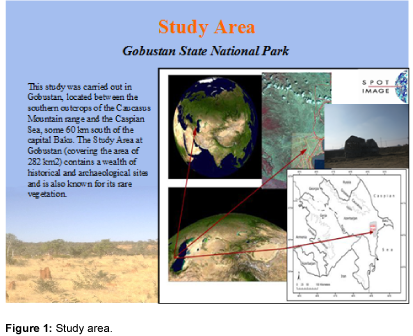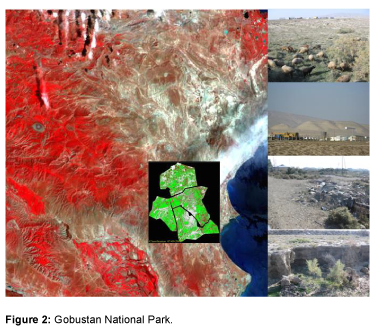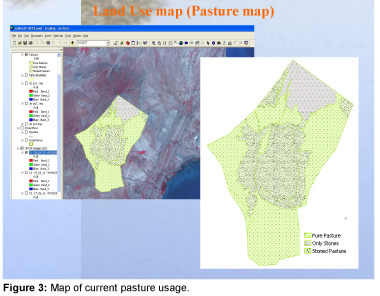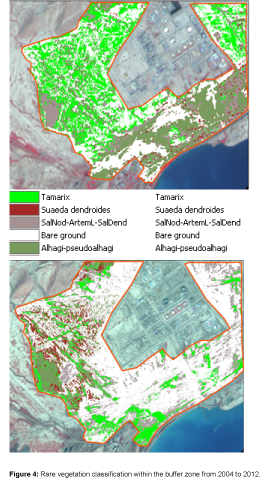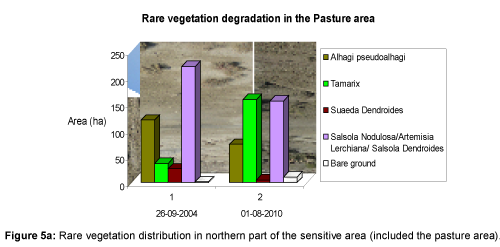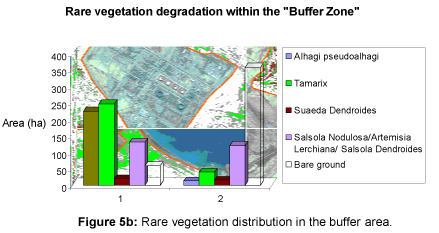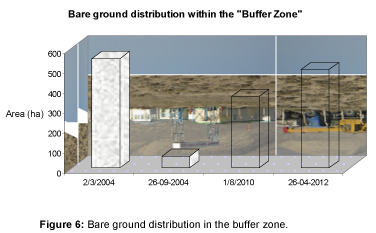Research Article Open Access
Rare Vegetation Degradation within Buffer Zones In Gobustan State National Park, Azerbaijan
Yelena M. Gambarova* and Adil Y. Gambarov
R.I.S.K. Company, R├?┬?├?┬?id Behbudov Küç├?┬?si, Bak├?┬▒, Azerbaijan
- Corresponding Author:
- Yelena M. Gambarova
R.I.S.K. Company, R├?┬?├?┬?id Behbudov
Küç├?┬?si, Bak├?┬▒, Azerbaijan
Tel: +994 12 497 37 37
E-mail: ElenaG@risk.az
Received April 06, 2016; Accepted April 21, 2016; Published April 25, 2016
Citation: Gambarova YM, Gambarov AY (2016) Rare Vegetation Degradation within “Buffer Zones” In Gobustan State National Park, Azerbaijan. J Earth Sci Clim Change. 7:344. doi:10.4172/2157-7617.1000344
Copyright: © 2016 Gambarova YM, et al. This is an open-access article distributed under the terms of the Creative Commons Attribution License, which permits unrestricted use, distribution, and reproduction in any medium, provided the original author and source are credited.
Visit for more related articles at Journal of Earth Science & Climatic Change
Abstract
This paper investigates the spatial change of rare vegetation cover of Gobustan, Azerbaijan. The Gobustan State National Park (Conservation Area) is a nationally important desert/semi-desert located west and south-west of Baku, Azerbaijan. In 2007 Gobustan was declared a UNESCO World Heritage Site considered being of "outstanding universal value" for the quality and density of its rock art engravings. The Study Area at Gobustan contains a wealth of historical and archaeological sites and is also known for its rare vegetation. This investigation includes monitoring of existing threats to rare vegetation (Global Climate Change, oil and gas exploration, overgrazing of winter and summer pastures by domestic sheep, goats and cattle, pollution, etc.) as well the processing of remote sensing data to produce “measured” vegetation indicators. This study has shown that oil and gas infrastructure, in an ecologically important semi-arid region, has a negative effect on species abundance and cover of vegetation. Rare vegetation classification within a buffer zone indicates: Plant cover has decreased in the buffer zone and is higher than the Sensitive Area. Bare ground has increased dramatically in the buffer zone whereas in the Sensitive Area it has decreased slightly.
Keywords
Rare vegetation, Climate change, Overgrazing, Infrastructure development, Remote sensing
Introduction
The Gobustan is located between the southern outcrops of the Caucasus Mountain range and the Caspian Sea, some 60 km south of the capital Baku as in presented in the Figure 1. The Gobustan semi desert extends on 1780 km2 (1,78,700 hectares) and is characterized by a semi-arid climate with continental influence and humid, cool winters and dry hot summers. The mean July temperature reaches 26.4°C and the mean January temperature 2°C in this area. Average rainfall is 200- 400 mm per year in Azerbaijan but can be as little as 150-200 mm in semi-desert areas such as Gobustan (National Hydro-Meteorological Service 2004, Azerbaijan) [1].
Threats to Rare Vegetation
The Project includes monitoring of existing threats to rare vegetation (Global climate change, oil and gas exploration, overgrazing of winter and summer pastures by domestic sheep, goats and cattle, pollution, etc.) Figure 2.
The methodological approach of this project includes training in the field of identification and census methods and the use of standardized monitoring methods. Remote Sensing (RS) and Geographic Information Systems (GIS) together form a powerful information acquisition and analysis tool for monitoring environmental changes. In order to trace the dynamics of rare vegetation distribution over the period from 2004 to 2012, we have selected the part of Gobustan area, where the vegetation is most sensitive to threats such as overgrazing, infrastructure, etc. (Figure 3).
Data and Methodology
The fundamental basis of this Project is Remote sensing imageries which came from Spot Image in 2.5 M, 5 M and 10 M resolution [2,3]. We have SPOT5 images from 2004 to 2014 years. In combination with more recent data (SPOT4 satellite data from 2010 and 2014), these early images enable us to study how Study area has changed over time (Figure 4).
Vegetation Response to Grazing By Livestock
Map of current pasture usage
Purpose: To provide data on the extent of pasturelands in Gobustan National Park for rare vegetation conservation.
Vegetation response to industrial development
Assessing protected area effectiveness using surrounding (buffer) areas environmentally similar to the target area. Many studies are based on the assumption that an area and its surrounding (buffer) area present similar environmental conditions and can be compared. For example, in order to assess the effectiveness of a protected area, the land use/cover changes are compared inside the park with its surroundings. The plan also proposes ‘buffer’ zones – areas between Industry Zone and non-industrial protected area [4].
The “buffer area” (10 km2) surrounds the industrial zone
This study has shown that oil and gas infrastructure, in an ecologically important semi-arid region, has a negative effect on species abundance and cover of vegetation (Figure 5a).
Rare vegetation classification within a buffer zone indicates
Plant cover has decreased in the buffer zone and is higher than the Sensitive Area. Bare ground has increased dramatically in the buffer zone whereas in the Sensitive Area it has decreased slightly (Figure 5b).
Bare ground is the non-vegetated, non-litter-covered part of the land surface. It includes scree, bare soil and subsoil, erosion pavement and exposed bedrock. An increase in bare ground is likely to indicate an increase in soil erosion [5,6].
Bare ground has increased dramatically in the buffer zone whereas in the Sensitive Area it has increased slightly (Figure 6).
Results and Discussion
The results indicates that major changes in the study area from 2004 to 2012 years involved decrease in vegetation cover types including Alhagi pseudoalhagi (-11.5%), Salsola nodulosa/Artemisia lerchiana/ Salsola dendroides communities (-18.6 %) and Suaeda dendroides (-5.24 %); and increase in Tamarix (+30.4 %) and Bare ground (+2.1 %) (Table 1).
| Rare vegetation communities |
Area in hectares, 26-09-2004 |
% of the area | Area in hectares, 01-08-2012 |
% of the area | % change between both periods |
|---|---|---|---|---|---|
| Alhagipseudoalhagi | 118.9 | 29.5 | 72.1 | 18.0 | 11.5 decrease |
| Tamarix | 36.13 | 9.0 | 158.0 | 39.4 | 30.4 increase |
| Suaeda dendroides | 26.02 | 6.5 | 5.04 | 1.26 | 5.24 decrease |
| Salsola nodulosa/ Artemisia lerchiana/ Salsola dendroides |
220.9 | 57.4 | 155.4 | 38.8 | 18.6 decrease |
| Bare ground | 1.58 | 0.4 | 10.1 | 2.5 | 2.1 increase |
Table 1: Rare vegetation changes from 2004 to 2012.
Acknowledgment
This work was supported by Rufford Small Grant Foundation which provided recourses for this research that led to this paper.
References
- Hoffer R (1978) Biological and physical considerations in applying computer- aided analysis techniques to remote sensor data. In remote sensing: The quantitative approach by Swam PH and Davis SM (eds.) USA, McGraw-Hill.
- Singh A (1989) Review article: Digital change detection techniques using remotely sensed data. Int J Remote Sens 10: 989-1003.
- Sader S, Winne J (1992) RGB-NDVI color composites for visualizing forest change dynamics. Int J Remote Sens 13: 3055-3067.
- Galvгo L, Vitorello I, Pizarro M (2000) An adequate band positioning to enhance NDVI contrasts among green vegetation, senescent biomass, and tropical soils. Int J Remote Sens 21: 1953-1960.
- Adia S, Rabiu A (2003). Change detection of vegetation cover, using multi-temporal remote sensing data and GIS techniques. Geospatial Application Papers, Environment.
- Lillesand T, Kiffer R (2007). Remote sensing and image interpretation. NewYork, John Wiley & Sons.
Relevant Topics
- Atmosphere
- Atmospheric Chemistry
- Atmospheric inversions
- Biosphere
- Chemical Oceanography
- Climate Modeling
- Crystallography
- Disaster Science
- Earth Science
- Ecology
- Environmental Degradation
- Gemology
- Geochemistry
- Geochronology
- Geomicrobiology
- Geomorphology
- Geosciences
- Geostatistics
- Glaciology
- Microplastic Pollution
- Mineralogy
- Soil Erosion and Land Degradation
Recommended Journals
Article Tools
Article Usage
- Total views: 11740
- [From(publication date):
April-2016 - Apr 03, 2025] - Breakdown by view type
- HTML page views : 10742
- PDF downloads : 998

